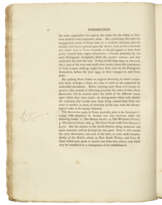ID 1349720
Lot 131 | [Matthew Flinders (1774-1814)]
Estimate value
£ 7 000 – 10 000
A George III mahogany writing slope, c.1800
The hinged top with gilt-tooled leather inset, opening to reveal a well with an arrangement of short drawers and one dummy drawer which corresponds to the short drawer to right return, with lower moulding to three sides and later baize cloth to underside
6 ¼ in (15.5cm) x 27 in (68.5cm) x 20 in (50cm)
Provenance: Anne Petrie (née Flinders, 1812–1892, daughter of Matthew Flinders: c.1900 ink annotation inside hinged top recording her ownership and likely inheritance from her father); and by direct descent in the Flinders family.
A writing slope probably in the possession of Matthew Flinders aboard HMS Investigator on the first circumnavigation of Australia. In 1798-1799, Matthew Flinders commanded the Norfolk, proving the existence of Bass Strait between mainland Australia and Van Diemen's Land (Tasmania). Upon his return to Britain, he was appointed in 1801 to command the Investigator for a more systematic examination of the Australian coastline. The Investigator was a small ship of 334 tons, with a crew of only 80 men, including several scientists and artists such as Robert Brown, the botanist, and Ferdinand Bauer, the botanical artist, as well as two Aboriginal people as guides, Bungaree and Nanbaree, who joined in Sydney. For such an ambitious voyage of exploration, both crew and ship were relatively small, but it was liberally equipped by the Admiralty, and the East India Company also granted the officers £600 for their outfit. Presumably this writing slope would have been part of Flinders’ outfitting of his own quarters. Used for entering log entries and writing correspondence, one can imagine such a writing slope surrounded by the charts, books and instruments that were necessary for such a voyage. The expedition set sail from England on 18 July 1801 and began the circumnavigation of Australia in December 1801 after reaching Cape Leeuwin. They completed the journey in June 1803 when they returned to Sydney.
| Artist: | Matthew Flinders (1774 - 1814) |
|---|---|
| Medium: | Wood |
| Place of origin: | Northern Europe, Europe, United Kingdom |
| Auction house category: | Furniture and Lamps |
| Artist: | Matthew Flinders (1774 - 1814) |
|---|---|
| Medium: | Wood |
| Place of origin: | Northern Europe, Europe, United Kingdom |
| Auction house category: | Furniture and Lamps |
| Address of auction |
CHRISTIE'S 8 King Street, St. James's SW1Y 6QT London United Kingdom | |
|---|---|---|
| Preview |
| |
| Phone | +44 (0)20 7839 9060 | |
| Buyer Premium | see on Website | |
| Conditions of purchase | Conditions of purchase |
![[Matthew Flinders (1774-1814)] - photo 1 [Matthew Flinders (1774-1814)] - photo 1](/assets/image/picture_4361342/10d80/1a5a6350e3df1a0e6541a9cedbd040ea1733871600jpg__fix_555_460.jpeg)
![[Matthew Flinders (1774-1814)] - photo 2 [Matthew Flinders (1774-1814)] - photo 2](/assets/image/picture_4361343/41669/72df0a2f861d68cbc5aff25b4faba98a1733871600jpg__fix_555_460.jpeg)
![[Matthew Flinders (1774-1814)] - photo 3 [Matthew Flinders (1774-1814)] - photo 3](/assets/image/picture_4361344/b5cd9/21cc76e0d530e31a6015602e2ea7d3bc1733871600jpg__fix_555_460.jpeg)


![[Matthew Flinders (1774-1814)] - photo 1 [Matthew Flinders (1774-1814)] - photo 1](/cache/lot/1349720/1a5a6350e3df1a0e6541a9cedbd040ea_1733871600-80x80_center_50.jpg)
